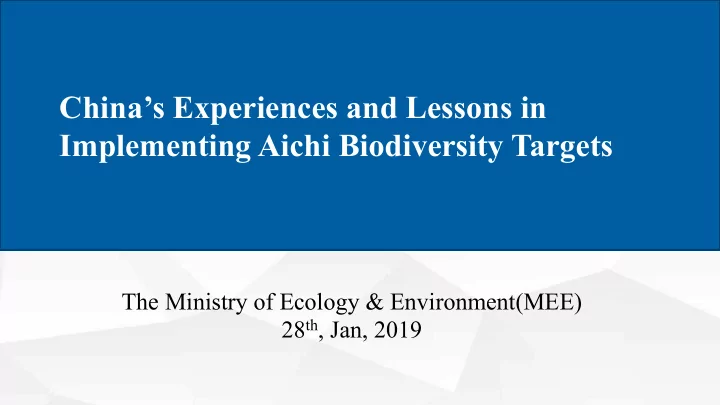

China’s Experiences and Lessons in Implementing Aichi Biodiversity Targets The Ministry of Ecology & Environment(MEE) 28 th , Jan, 2019
Outlines 01 Backgrounds 02 Progress in implementing Aichi Biodiversity Targets 03 Experiences 04 Lessons learned 05 Conclusions
Backgrounds 3 vascular plants inland water fishes amphibians mammals • More than 90,000 of known species and sub- species reptiles birds • The number of higher plant species ranks the third in the world • The number of mammals ranks first in the world Figure Spatial distribution of wild vascular plants and vertebrates in China
China NBSAP (2011-2020) 4 China's Priority Areas for Biodiversity conservation • guiding principles, strategic goals and tasks for Objects biodiversity conservation in next two decade • 10 priority areas, 30 priority actions and 39 priority Actions projects for biodiversity conservation • 35 priority regions for biodiversity conservation Priority areas
6th National Report 5 Launched China’s Sixth National Report at the side events of 2018 UN Biodiversity Conference
Overall progress 6 Targets Targets Target 1 Target 11 Target 2 Target 12 4 3 Target 3 Target 13 Target 4 Target 14 Exceeding target 13 Target 5 Target 15 On track to achieve target Target 6 Target 16 Progress towards target Target 7 Target 17 but at an insufficient rate Target 8 Target 18 Figure. The proportion of Aichi Targets that are Target 9 Target 19 exceeding the target, on track or with an insufficient rate Target 10 Target 20
Experiences 7 Ecological civilization Social Overall strategy Political Economic Cultural President Xi of China attended the meeting made an important speech Lucid waters and lush mountains are Adhere to the harmonious coexistence invaluable assets between humans and nature Six principles of ecological A good ecological environment is the most Mountains, water, forests, fields, lakes, civilization popular welfare for the people. grasses are communities of life construction Protecting the ecological environment with Collaboration on the construction of the strictest rules of the strictest system global ecological civilization
Experiences 8 Ministry of Ecology Ministry of Natural and Environment Resources Mountains, water, forests, fields, Ecology & lakes, Natural Environment grasses are communities of life resources assets quality management supervision Ecosystem based approach
Experiences 9 The level of financial input in nature China's annual GDP growth rate reserves of China Amount/a hundred million Rate/% Year Year China's non-fossil energy ratio over the China’s carbon emission per GDP unit years Tens/ten thousand yuan Rate/% Biodiversity Year Year Transformational change for development
Experiences 10 • 31 provincial administrative units have National spatial patterns for Ecological red lines initialized ecosystems protecting redlines identification of process The results of ecological Spatial pattern of ecosystem conservation redlining service functions The redline zones cover an area of 1.29 million square kilometers, with a ratio of 24.76%.
Experiences 11 • Adhere to ecological protection first NATIONAL • Insist on nationally representative TYPE NUMBER LEVEL • Adhere to the public welfare of the Nature reserve 2750 463 whole people Scenic spot 962 244 Forest park 3505 881 Geological park 241 241 Wetland Park 979 705 56 56 Special marine reserve(including ocean park) Water park 2500 719 Aquatic germplasm resources 487 487 conservation zone National Park 25 10 Desert park 55 55
Enhancing ecosystem conservation and restoration 12 Desertification Control in Western Inner Mongolia Changing Trends in Typical Vegetation of Loess Plateau Wildlife Returning Control of Returning Forest belt protection and farmlands rockization and grazing to construction nature reserve to forests and desertification grasslands construction grasslands
Experiences 13 Green development indicator system Improvement of the ecological environment of Qilian Mountain Ecological Civilization Construction Ecological performance Assessment Target System appraisal Demolition of illegal buildings Transformation in government performance system and law enforcement
Experiences 14 Lancang-Mekong SSC Cooperation China-EU Summit COOPERATIO N TEM EXCHANGES M BRICS Environment Ministrial Meeting
Lessons learned 15 Conflicts between socio-economic development and conservation remains Fund management is yet to be further improved Lesson s Scientific and technical support capacities are learned yet to be further enhanced The public awareness and participatory capacities are yet to be upgraded
Conclusions 16 • Mainstreaming biodiversity into major agenda of socio-economic development helps to make synergies among policies to enhance the effectiveness of biodiversity conservation, and high-level political support helps this; • Best practices at national level are valuable references and need to be take into consideration when developing Post-2020 frameworks; • Financial resources, technology and capacity building are critical to make the priorities and actions in NBSAP be implemented.
THANKS
Recommend
More recommend